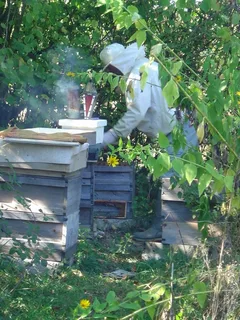other

August 07,2025 • 5 min read
Paint Bee Hives for Better Hive Management: Here’s How

If you’re getting into beekeeping, there’s a good chance you’re thinking about bees, suits, smokers, and hive tools. But here’s something many new beekeepers overlook: painting your bee hives. It’s not just about making your boxes look nice—it’s an essential step in hive management, one that helps with weatherproofing, durability, and overall bee health.
Whether you're prepping your first hive or maintaining a growing apiary, painting can make a big difference. Let’s walk through how to do it right—especially if you're just starting out and looking for the best bee suits for beginners.
Why Painting Your Bee Hives is More Than Just Cosmetic
A well-painted hive protects the wood from moisture, mold, pests, and temperature swings. This matters because untreated wood wears down quickly in the elements, leading to warping, cracking, and even colony loss.
But beyond durability, painting also helps with apiary organization. Different colors can help you identify specific colonies or reduce drift (when bees return to the wrong hive). It’s a simple but smart move in your hive maintenance toolkit.
Choosing the Right Paint and Materials for Your Beehives
Bee-Safe Paints: What to Use and What to Avoid
Not all paints are created equal. You want to go with non-toxic, low-VOC (volatile organic compounds) paints—ideally water-based latex paints. These are safer for the bees and better for the environment. Avoid oil-based or heavily scented paints that might harm or confuse your colony.
Stick to light colors like white, cream, or pastels. These help reflect sunlight and keep the hive cooler in summer. Darker colors absorb heat and can make conditions inside the hive uncomfortable—especially in warmer climates.
Tools You’ll Need for a Safe and Smooth Job
You don’t need fancy gear, but a few tools will make your job easier:
-
A paintbrush or roller (foam rollers work great on flat hive surfaces)
-
Sandpaper or a sanding block to smooth rough wood
-
Drop cloth or newspaper to protect the ground
-
And of course, protective beekeeping gear
If you’re already suiting up for beekeeping, you might as well invest in the best bee suits for beginners—ones that are lightweight, breathable, and offer solid protection, especially when working around the hive during setup or maintenance.
How to Paint a Beehive the Right Way
Step-by-Step Guide to Painting Wooden Bee Hives
-
Sand the surface – Start with clean, dry, and smooth hive boxes. Sand down rough edges.
-
Prime the wood (optional but recommended) – Especially for raw wood, primer helps paint stick better and last longer.
-
Apply your paint – Use even strokes and make sure to cover all exposed surfaces—but never paint the inside of the hive or the entrance reducer.
-
Let it dry fully – One coat might do, but two coats offer longer protection. Allow each coat to dry thoroughly.
-
Cure time matters – Let the hive boxes cure for at least 24–48 hours in a well-ventilated area before introducing bees.
When and Where to Paint Your Hive
Paint your hive before installing bees, ideally in dry, mild weather. Spring is a perfect season for painting, as temperatures are warming and there’s less humidity. Avoid painting during the rain or extreme heat. Proper curing ensures the paint won’t off-gas harmful chemicals when the bees move in.
Best Bee Suits for Beginners: Stay Safe While You Paint
Even if your hive is empty, bees from nearby colonies may be curious while you work—especially if you're painting outdoors in warm weather. This is where having the best bee suit for beginners comes in handy.
Look for features like:
-
Ventilated fabric – Keeps you cool during sunny hive prep days
-
Elastic cuffs and zippers – Prevents bees from sneaking in
-
Detachable veils – Let you remove the head covering when not needed
-
Easy-to-clean material – Because painting gets messy
Good beginner beekeeping suits aren’t just for inspections. They’re also useful for all kinds of hive setup and maintenance tasks—painting included.
Common Mistakes to Avoid When Painting Bee Hives
Even experienced beekeepers slip up sometimes. Here are a few things to watch out for:
-
Painting while bees are active – Even a gentle colony can get defensive if you’re working near them with strong-smelling paint.
-
Skipping dry time – Rushing this step can cause paint fumes to linger inside the hive.
-
Using the wrong paint – Glossy, oil-based, or dark-colored paints can overheat the hive or introduce toxic chemicals.
-
Painting interior surfaces – Always leave the inside of the hive unpainted. Bees coat it with propolis naturally.
Final Thoughts: Painting for Long-Term Hive Management Success
Painting your hive is one of the simplest, most cost-effective ways to support long-term hive management. It protects your investment, keeps your beekeeping gears more comfortable, and saves you future maintenance headaches.
Combine this with smart prep, bee-safe paint, and the best bee suits for beginners, and you're setting yourself up for a productive, well-managed season. Whether you're painting your first hive or refreshing an old one, the time and care you put in now will pay off for many seasons to come.
Sam Jhons Details
User Profile
- Full name
- Sam Jhons
- Email address
- samjhons19@gmail.com
- Join Date
- 2025-08-07
- State
- City
- Pincode
- Address
- Follow us on Facebook
- Follow us on Twitter
- Website Name
- Bio